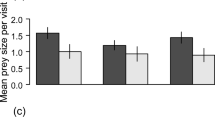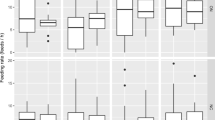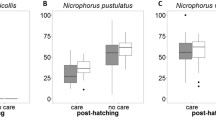Abstract
In the meerkat (Suricata suricatta), a cooperative mongoose, pups follow potential feeders while the group is foraging and emit incessant calls when soliciting food from them. In contrast to a ’stationary’ brood of chicks, in which nestlings are fed at a fixed location, meerkat pups are ’mobile’ and become spread out. The question arises whether meerkat pups that experience different constraints to those facing chicks have evolved similar begging strategies. This paper describes the vocalisations that meerkat pups emit in the context of begging and investigates the influence of these calls on food allocation by older group members and on the behaviour of littermates. Meerkat pups use two types of calls when soliciting food from a potential feeder. The most common is a ’repeat’ call, which pups emit continuously when following an older forager over several hours a day. In addition, when a potential feeder finds a prey item, the pups next to it emit a bout of calls with increased calling rate, amplitude and fundamental frequency, termed ’high-pitched’ calls. Observations, together with playback experiments, showed that more prey was allocated to pups that called longer and more intensely. The pup closest to a feeder was almost always fed. The probability of emitting high-pitched calls did not depend on the time since a pup had received food, and the change from repeat to high-pitched calls occurred suddenly. The main function of the high-pitched call, therefore, does not appear to be to signal a pup’s hunger state. More likely, the two calls, in the context of begging, may be an adaptation to energetic constraints in a mobile feeding system. Pups, which are dispersed during foraging, may emit repeat calls over long periods to prevent potential feeders from eating all the prey themselves. At the moment a potential feeder finds prey, pups may give the more intense high-pitched calls to direct feeders to bring the food item to them and not to a littermate. Therefore, unlike the stationary feeding system where chicks emit one type of begging call when the feeder approaches the nest, meerkats, with a mobile feeding system, have evolved two discrete types of vocalisations in the context of begging.
Similar content being viewed by others
Author information
Authors and Affiliations
Additional information
Received: 22 November 1999 / Revised: 1 July 2000 / Accepted: 17 July 2000
Rights and permissions
About this article
Cite this article
Manser, M., Avey, G. The effect of pup vocalisations on food allocation in a cooperative mammal, the meerkat (Suricata suricatta). Behav Ecol Sociobiol 48, 429–437 (2000). https://doi.org/10.1007/s002650000248
Issue Date:
DOI: https://doi.org/10.1007/s002650000248




